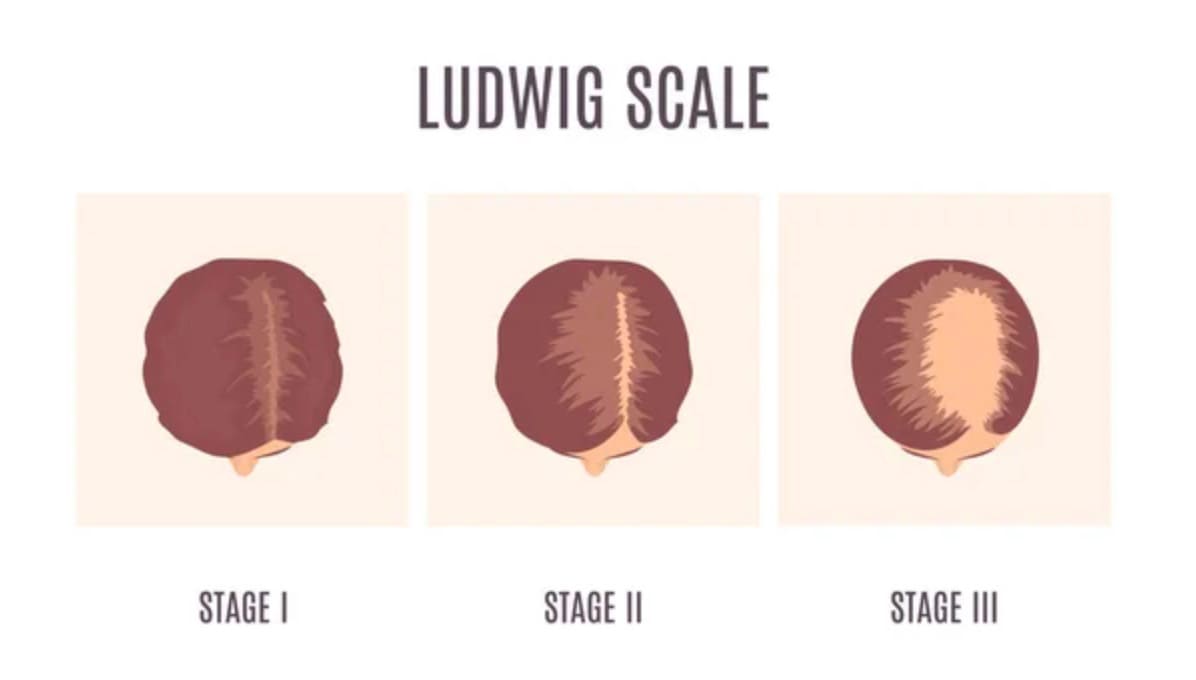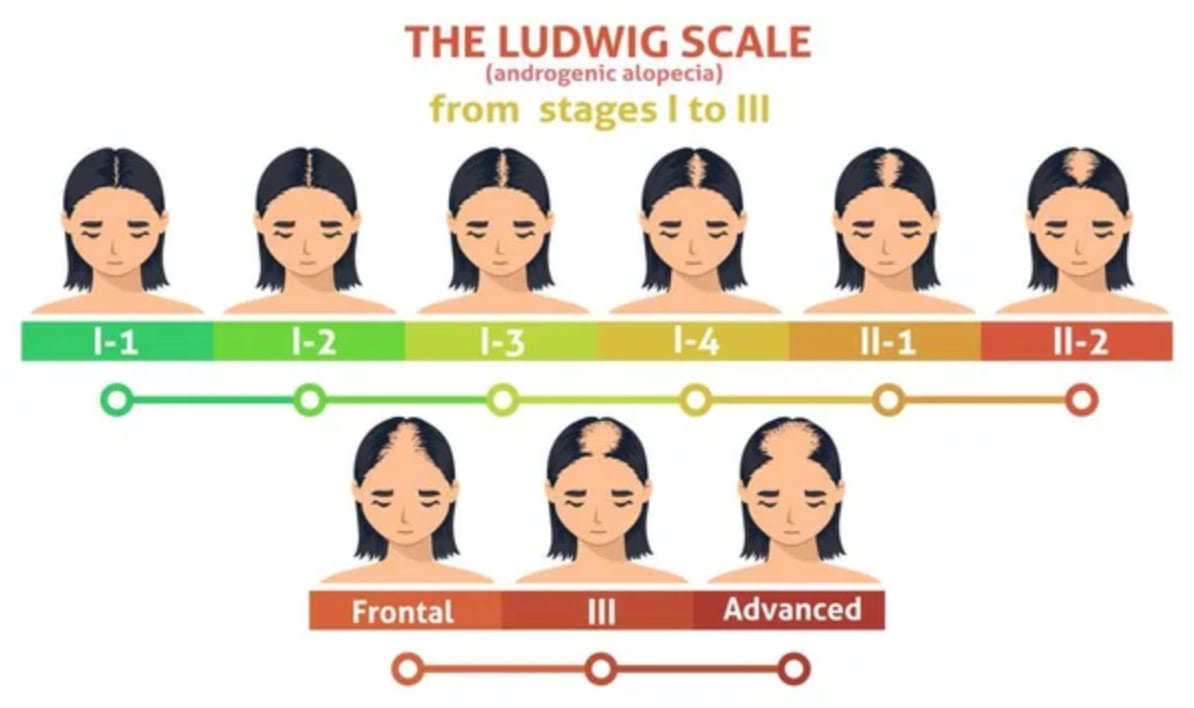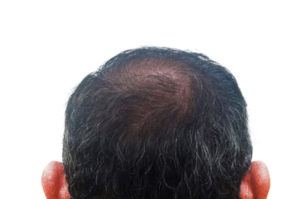Have you ever wondered how the different stages and severities of female pattern baldness are categorised? Have you ever thought about why many women suffer with hair loss in the same places of the head? Well, we’ve devised this page to help you find answers!
On this page, you’ll find out why women suffer with hair loss, how clinicians diagnose baldness, and what women can do to fix their patterned hair loss. You’ll also find out how the Ludwig Scale is used by hair transplant surgeons.
What is the Ludwig Scale?
The Ludwig Scale is a classification system used by hair transplant surgeons to gauge levels of androgenic alopecia in female hair loss patients. Split into three major sections (1.1 being a full head of hair and 3.3 the most severe stage of hair loss), the Ludwig Scale is a common tool used by any hair loss specialist to diagnose a patient’s patterned hair loss and suggest which surgical hair transplant procedure is going to be most effective at promoting new hair growth.
 As can be seen, the three stages of baldness, according to the Ludwig scale, is likely to proceed as follows:
As can be seen, the three stages of baldness, according to the Ludwig scale, is likely to proceed as follows:
- Type I – minimal thinning of the mid-line parting in the hair
- Type II – gradual thinning and noticeable widening of the mid-line parting in the hair
- Type III – Heavy to total thinning of the mid-line parting in the hair. In the most extreme cases, the top of the head is totally bald.
Depending on where you fall in the Ludwig Scale helps hair transplant surgeons to work out what type of hair transplant you ay require. In almost all cases, follicular unit extraction (FUE) is often the most suitable course of action. This process is minimally invasive and stop hair thinning long-term.
Female Pattern Hair loss
Female pattern baldness is, more often than not, hereditary. This means you will have inherited it off one of your parents. Sometimes this may cause smaller hair follicles or thinner strands of hair in women. Equally, female pattern hair loss may cause a shorter hair-growing period and a longer shedding phase. With female androgenetic alopecia, progressive thinning of the hair will continue in a systematic manner.
Similarly, female pattern baldness can also occur as a result of environmental factors too. A woman’s age, hormones, and the menopause may speed up female pattern baldness as oestrogen levels reduce.
Ludwig Scale Type 1
 Within stage 1, there are three sub-stages that a woman may go through. From 1.1 to 1.2, this is often referred to as a natural hair parting. Hairs around this area are naturally thick with only a small amount of skin being able to be seen around the mid part. By 1.2 the scalp starts to thin ever so slightly around this area.
Within stage 1, there are three sub-stages that a woman may go through. From 1.1 to 1.2, this is often referred to as a natural hair parting. Hairs around this area are naturally thick with only a small amount of skin being able to be seen around the mid part. By 1.2 the scalp starts to thin ever so slightly around this area.
Early signs of hair loss would be easy to spot. Be sure to observe your hair in a mirror every couple of weeks if you think you’re beginning to thin a little. If there is a general decrease in the thickness of hair, be sure to book an appointment with a doctor/GP.
At this point, it is unlikely that a hair transplant would be recommended for patients. Instead, a hai
r loss specialist would likely recommend a chemical treatment such as finasteride or minoxidil. This will not stop hair loss altogether but will, instead, slow the process down as these drugs act as DHT blockers and thus try to prevent any further hair shedding.
If you are towards stage 1.3, then PRP treatment is something that will be looked at in order to thicken the area up as it is a clinically proven hair loss treatment.
Ludwig Scale Type 2
 By stage 2, hair loss progresses and thinning on the top of the head is more visible. Overall, a woman may feel there is a considerable decrease in the volume of hair around this area. Many patients come to us around this point on the Ludwig Scale.
By stage 2, hair loss progresses and thinning on the top of the head is more visible. Overall, a woman may feel there is a considerable decrease in the volume of hair around this area. Many patients come to us around this point on the Ludwig Scale.
Typically, hair transplant surgeons would plan for a course of FUE. This is because the process is minimally invasive, leaving no scar, whilst visibly thickening the hair in the mid part area.
Ludwig Scale Type 3
 This is the most severe type of female pattern baldness. By Stage 3, hair loss of the mid parting becomes extreme and may even affect the front hairline. Large areas of the top of the head would be completely bald giving no chance of hair regrowth without a hair transplant.
This is the most severe type of female pattern baldness. By Stage 3, hair loss of the mid parting becomes extreme and may even affect the front hairline. Large areas of the top of the head would be completely bald giving no chance of hair regrowth without a hair transplant.
The best course of action for treating stage 3 on the Ludwig Scale would be a FUE hair transplant, backed up by future PRP treatments. Obviously, this would likely cost more as the hair loss would have progressed more than any of the previous stages.
How do I know if I’m progressing down the Ludwig Scale?
Although it is definitely easy to spot what general stage you may be categorised as, it is often difficult to gauge what substage of female pattern hair loss you may be experiencing. If you’re struggling to notice a difference, be sure to look out for these symptoms of hair loss:
- Thinning Hair – if you notice that your hair is not as thick and full as usual, this may be a sign that your female hair loss is progressing.
- Hair Loss on Pillow/in Shower – if you are beginning to notice bald spots in your hair, this could be indicative of female pattern hair loss.
- Fine or Delicate Hair Follicles – if you notice your hairs seem to be more delicate than usual and prone to breakages, this may be an indication that you are suffering with pattern baldness.
- Itchy or Painful Scalp – if you are in a constant state of discomfort, this may be indicative of autoimmune condition, or even something as simple a scalp infection. Although this may not be indicative of female pattern hair loss, it definitely wont help matters!
If you’re suffering with any of these symptoms, be sure to book yourself a free consultation with one of our doctors. Each surgeon at our clinic is experienced in diagnosing and treating all forms of hair loss in women!
Book your free consultation today to begin your hair restoration journey!








